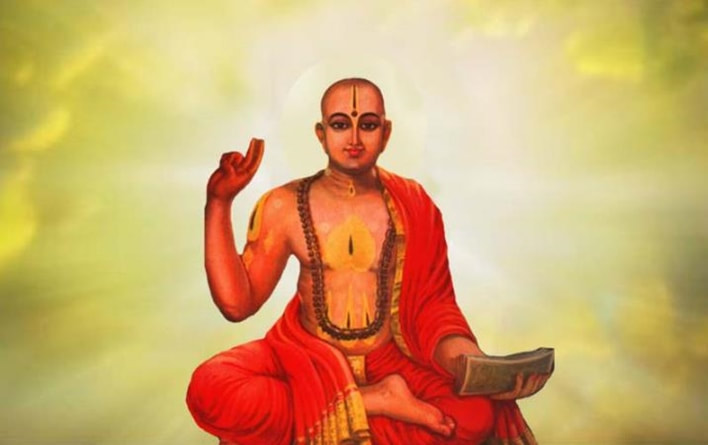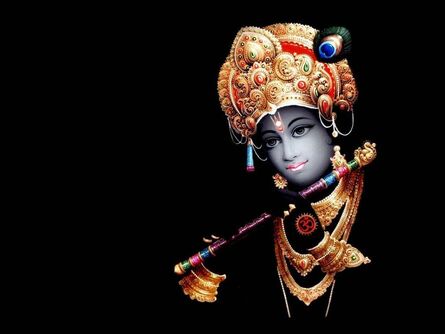|
Sri Madhvacharya, the dualist
Sri Madhvacharya was born on family of Tulu Brahmin, near Udupi, Karnataka. he lived during 1238-1317. Sri Madhva was also known by three other names – Vasudeva, Purnaprajna and Anandatirtha. He demonstrated that each Vedic Sukta had three meanings, the Mahabharata ten meanings, and each word of the Vishnu-sehsranama, a hundred meanings. He introduced the use of animal forms made of a paste of black gram power and ghee in place of animals in sacrifices. He proclaimed that in most ancient days Vedic rituals did not allow animal sacrifice. He, besides philosophical works, influenced great devotional movement known as Dasa Kuta, in Karnataka. He also made excellent arrangements for worship in the temple by founding eight Maths in Udupi. Madhva, unlike all other vedantic acharyas, built an intellectual structure to stimulate people to sustain their faith in a real God and real spiritual destiny for human beings to be attained through devotional disciplines enlivened and enlightened by love and knowledge, and crowned by the grace of God. Madhva’s philosophy is called Dvaita or the Doctrine of the Two, because it accepts two entirely separate substances, the independent reality (God) and the Dependent reality (the Jivas, Nature and other allied categories). He challenged the philosophy of Advaita (philosophers – Sri Gaudapada & Sri Adishankaracharya) and put forth following reasoning: Theory of Illusions (Khyati-vada): Advaitia Philosophy: According to Advaita philosophy (means Non-dual), Brahman is the one and only reality and everything else is a mere illusion. Maya creates apparent multiplicity in a universe where only Brahman really exists. One of the most common examples used to describe the state is momentarily seeing a snake in a rope when it is lying in the darkness. The Advaita system has three levels of experience as under:
Advaitins maintain that Vyavaharika is sublated (taken away) when consciousness get established in Paramarthika level. The Vyavaharika world is then realized as disappearing. The evidence is of the perfected sage. Dvaita Philosophy: However, Dvaitins dispute both claims of Advaitins. If there is a at all a non-dualistic experience, it is only the temporary disappearance of world consciousness in the blissful absorption of the Jiva in mystic communion with the divine. The Vaisnavite doctrine claims:
Location of Avidya: According to the Advaita Philosophy, Jiva is one with Brahman and this assumes Avidya being in Brahman. Brahman will thus become the center of all corruption. As per Dvaita philosophy, Avidya has its locus only in the Jiva. So their theory of Avidya is called Svabhavajnana-vada, which means the forgetfulness of the Jiva’s true nature and of his dependence on God. It is induced in them by the Independent Being, God. As Jiva is different from Brahman, Avidya is located in the Jiva does not affect Him as in Advaita. Though located in the Jiva, it is not natural to him. For being, an eternal category and a reflection of God, the Jiva’s existentiality and self-consciousness are retained, but his blissful nature is gravely clouded and bodily identification is generated. Reference: Bhakti Schools of Vedanta – by Swami Tapasyananda, Sri Ramakrishna Math, Chennai.
0 Comments
Shri Krishna, the Almighty
श्रीकृष्ण गोविन्द हरे मुरारे । हे नाथ नारायण वसुदेवा । Shri Krishna appeared on the earth around 5122 years ago to teach the human beings, how to lead balanced life. As in human form, he had to undergo both pleasures and pains. Shri Krishna taught not to crave for power, wealth, kingdom, fame etc. which are mundane desires. He set ideals for different relationships. Various events occurred during his life, displayed these attributes. Bhagwan Sri Krishna displayed sixteen attributes viz. compassion, patience, forgiveness, impartiality, justice, impartiality, detachment, meditation & spiritual powers, invincibility, beneficence, beauty incarnate, best of dancer, best of singer, honesty, truthfulness, Perfect master of all arts, such as poetry, drama, painting etc. and controller of all & controller of self. Moreover, he displayed fearlessness, freedom from anger; renunciation, tranquility, steady determination, vigor, etc. In Human form enjoyed pleasures as well as pain -Shri Krishna suffered more than anybody else. But, smile never left his lips.
Displayed control over senses –Shri Krishna displayed control over senses and took decisions in larger public interest.
War as a last resort –He tried to avoid killing Kansa, Shishupal, Narakasur and war between Kauravas & Pandavas.
No egoism, humbleness –
Spread love – Sri Krishna spread spiritual love throughout his life. He gave spiritual love to gopals & gopis in childhood, Udhav, Sudama, Padavas (friends), to deviki & Yashodha (mothers), etc. He even gave liberation to Putana who tried to kill him & Jara hunter who killed him. Taught respect for different relationships – Throughout his life, Shri Krishna played whatever role; He perfected that role and became role model.
Bhagwan Sri Krishna is called as Purna Avatara as he displayed sixteen “Kalas” viz.
|
Archives
May 2024
Categories |


 RSS Feed
RSS Feed